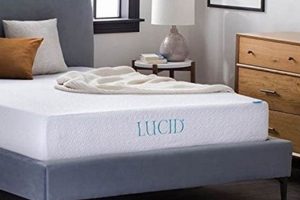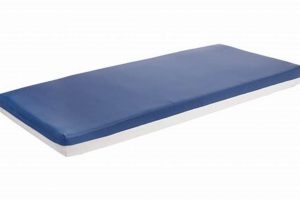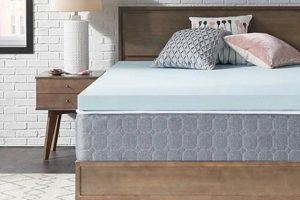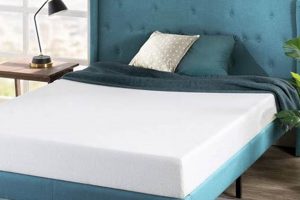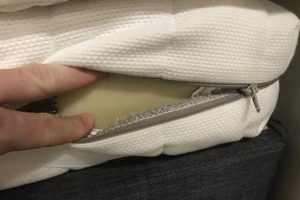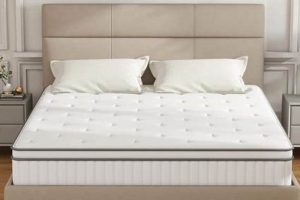This bedding accessory is designed to enhance the comfort and support of an existing mattress. It typically consists of a layer of viscoelastic foam infused with gel particles. The viscoelastic properties allow the material to conform to the body’s shape, distributing weight and reducing pressure points. The integration of gel is intended to dissipate heat, contributing to a cooler sleep surface. Such products are available in a variety of thicknesses and sizes to accommodate different mattress dimensions and individual preferences.
The appeal of this type of sleep surface enhancement lies in its potential to improve sleep quality and alleviate discomfort. By providing enhanced cushioning and contouring, it can assist in minimizing tossing and turning, leading to more restful sleep. Historically, the development of viscoelastic foam was initially driven by needs within the aerospace industry. Its application in bedding demonstrates its versatility and potential benefits for everyday comfort and well-being. The addition of gel technology marks a further refinement, addressing concerns related to heat retention commonly associated with traditional viscoelastic foam.
Subsequent sections will delve into specific features and considerations when selecting this type of product. These include an examination of density, thickness, gel type, and overall construction to help the consumer make an informed purchasing decision. Additionally, guidance will be provided on the proper care and maintenance to extend the lifespan and maximize the performance of this bedding enhancement.
Enhancing Sleep Quality
This section outlines crucial considerations for maximizing the benefits and longevity of bedding enhancements incorporating viscoelastic polymer and gel materials. Proper utilization and maintenance are paramount for achieving optimal sleep quality and extending the product’s lifespan.
Tip 1: Understand Density and Thickness: A higher density generally indicates greater durability and support. Consider body weight and sleeping position when selecting the appropriate thickness. Side sleepers may benefit from a thicker profile to cushion pressure points on hips and shoulders.
Tip 2: Evaluate Gel Infusion Type: Various gel infusion methods exist, each offering different levels of cooling. Gel beads or swirls are common, but more advanced technologies, such as phase-change materials, offer superior temperature regulation. Research the type of gel and its expected cooling performance.
Tip 3: Prioritize Breathable Cover Materials: The cover material significantly impacts airflow. Opt for covers made from breathable fabrics like cotton, bamboo, or specialized performance materials designed to wick away moisture. Avoid synthetic materials that trap heat.
Tip 4: Adhere to Proper Cleaning Protocols: Stains and spills should be addressed promptly according to the manufacturer’s instructions. Avoid harsh chemicals or abrasive cleaners that can damage the viscoelastic polymer. Spot cleaning is generally recommended over machine washing.
Tip 5: Ensure Adequate Support: Place the bedding enhancement on a stable and supportive mattress. A worn or sagging mattress will compromise the benefits of the viscoelastic polymer and gel layer, leading to uneven support and reduced comfort.
Tip 6: Rotate Regularly: Periodically rotate the bedding addition to promote even wear and prevent impressions from forming in high-pressure areas. The frequency of rotation will depend on individual usage patterns and product construction.
Tip 7: Consider Air Circulation: Ensure adequate ventilation in the bedroom to facilitate heat dissipation. Maintaining a cooler sleep environment will enhance the cooling properties of the gel and prevent overheating.
By adhering to these guidelines, individuals can optimize the performance and extend the lifespan of bedding enhancements incorporating viscoelastic polymer and gel materials. Careful consideration of density, gel type, cover material, and proper maintenance techniques will contribute to improved sleep quality and overall well-being.
The following sections will address common concerns and provide additional insights into the selection and utilization of bedding enhancements. The goal is to empower consumers with the knowledge necessary to make informed decisions and maximize the benefits of these sleep-enhancing products.
1. Density
Density is a critical characteristic when evaluating viscoelastic polymer and gel bedding layers. It significantly influences the support, durability, and overall performance of these products. A thorough understanding of density is essential for making informed purchasing decisions and ensuring optimal sleep quality.
- Support and Spinal Alignment
Density directly correlates with the level of support provided by the viscoelastic polymer. Higher density materials offer greater resistance to compression, which aids in maintaining proper spinal alignment. This is particularly important for individuals with back pain or those who prefer a firmer sleeping surface. Conversely, lower density materials may be more suitable for individuals who prefer a softer, more conforming feel.
- Durability and Longevity
Higher density viscoelastic polymer generally exhibits greater durability and resistance to breakdown over time. The cellular structure of the material is more compact, reducing the likelihood of permanent impressions or sagging. Lower density materials are more prone to compression and may lose their shape and supportiveness more quickly, resulting in a shorter lifespan.
- Weight and Handling
Density affects the weight and ease of handling. Higher density layers are significantly heavier than their lower density counterparts. This can impact the ease of installation, rotation, and cleaning. Consideration should be given to the physical demands of managing a heavier bedding layer, particularly for individuals with limited mobility.
- Heat Retention
While gel infusion aims to mitigate heat retention, density still plays a role. Higher density materials tend to have less airflow, potentially trapping heat. However, advancements in open-cell viscoelastic polymer and gel technologies are designed to address this issue. It’s essential to consider the overall design and construction of the bedding layer, including the cover material and ventilation features, to assess its heat regulation capabilities.
In summary, density is a key determinant of the support, durability, weight, and potentially the heat retention characteristics of viscoelastic polymer and gel bedding additions. Consumers should carefully consider their individual needs and preferences when selecting a product with an appropriate density to maximize comfort and longevity. Furthermore, it is important to view density in conjunction with other factors, such as gel type, cover material, and overall construction, to gain a comprehensive understanding of the product’s performa
nce capabilities.
2. Thickness
Thickness, in the context of viscoelastic polymer and gel bedding additions, refers to the vertical dimension of the layer. This measurement directly influences the level of comfort and support provided, playing a critical role in determining the suitability for individual needs and preferences.
- Pressure Relief Capacity
Thickness significantly impacts the degree of pressure relief. A thicker layer allows for greater contouring and distribution of body weight, reducing pressure points on areas such as hips, shoulders, and the spine. This is particularly beneficial for side sleepers who experience concentrated pressure on these areas. Thinner layers may offer less cushioning and may not be adequate for individuals seeking substantial pressure relief.
- Support and Spinal Alignment
While density plays a significant role in support, thickness also contributes to spinal alignment. A sufficient thickness is necessary to maintain the natural curvature of the spine, preventing sinking or sagging that can lead to discomfort and potential back problems. The appropriate thickness depends on factors such as body weight, sleeping position, and the firmness of the underlying mattress.
- Heat Retention Considerations
Thickness can influence heat retention. Thicker layers may trap more heat due to reduced airflow. However, the integration of gel particles and breathable cover materials can mitigate this effect. Manufacturers often employ open-cell viscoelastic polymer formulations to improve ventilation and reduce heat buildup in thicker bedding layers. Balance between thickness, materials, and ventilation is essential.
- Overall Comfort and Feel
Thickness contributes significantly to the overall comfort and feel of the sleep surface. A thicker layer provides a plusher, more luxurious feel, while a thinner layer may feel firmer and more responsive. Personal preference dictates the ideal thickness. Some individuals may prefer the enveloping sensation of a thicker layer, while others may prioritize the support and responsiveness of a thinner layer.
In conclusion, thickness is a crucial factor to consider when selecting viscoelastic polymer and gel bedding additions. It directly influences pressure relief, support, heat retention, and overall comfort. An informed assessment of thickness, in conjunction with density, gel type, and cover material, enables consumers to make choices that align with their individual needs and optimize their sleep experience.
3. Gel Infusion
Gel infusion is a critical feature often incorporated into viscoelastic polymer bedding layers to address the issue of heat retention commonly associated with traditional viscoelastic foam. The presence of gel aims to regulate temperature, contributing to a cooler and more comfortable sleep environment.
- Mechanism of Heat Dissipation
Gel particles, often incorporated as beads or swirls within the viscoelastic polymer matrix, act as thermal conductors. These particles absorb heat from the body and redistribute it throughout the bedding layer. This redistribution facilitates the dissipation of heat away from the sleeper, thereby reducing localized temperature buildup. Different types of gel infusions possess varying thermal conductivity properties, influencing their effectiveness.
- Types of Gel Infusion Technologies
Various methods of gel infusion exist, ranging from simple gel beads to more advanced phase-change materials. Gel beads and swirls are the most common and cost-effective. Phase-change materials (PCMs) offer superior temperature regulation by absorbing and releasing heat as they transition between solid and liquid states. These PCMs can maintain a more consistent temperature, minimizing temperature fluctuations throughout the night.
- Impact on Airflow and Breathability
While gel infusion aims to regulate temperature, it can also impact airflow within the bedding layer. Densely packed gel beads may restrict airflow, potentially counteracting the cooling benefits. However, open-cell viscoelastic polymer formulations and strategic placement of gel particles can mitigate this issue. The cover material also plays a crucial role in promoting breathability and facilitating heat dissipation.
- Influence on Firmness and Support
The incorporation of gel particles can slightly alter the firmness and support characteristics of the viscoelastic polymer. Gel-infused layers may exhibit a slightly softer feel compared to traditional viscoelastic foam. However, the density of the viscoelastic polymer and the concentration of gel particles ultimately determine the overall firmness and support level. Manufacturers carefully balance these factors to achieve the desired comfort and support characteristics.
The integration of gel infusion into viscoelastic polymer bedding represents a significant advancement in sleep technology. While the effectiveness of gel infusion can vary depending on the type of gel, the infusion method, and the overall construction of the product, it generally contributes to a cooler and more comfortable sleep experience. Consumers should carefully consider the specific gel infusion technology used and its potential impact on temperature regulation, airflow, firmness, and support when selecting a viscoelastic polymer and gel bedding layer. Furthermore, it is essential to view gel infusion as one component of a larger system that includes viscoelastic polymer density, cover material, and overall design.
4. Cover Material
The selection of the cover material for a viscoelastic polymer and gel bedding addition significantly influences its performance and the sleeper’s experience. The cover functions as an interface between the sleeper and the viscoelastic polymer core, impacting breathability, temperature regulation, and overall comfort. The material’s composition, weave, and construction directly affect airflow and moisture wicking, both critical factors in maintaining a comfortable sleep environment. For instance, a tightly woven polyester cover may impede airflow, potentially negating some of the cooling benefits of the gel infusion. Conversely, a loosely woven cotton or bamboo-derived rayon cover promotes breathability, facilitating heat dissipation and reducing the risk of overheating.
The properties of the cover material also affect hygiene and durability. Certain materials, such as those treated with antimicrobial finishes, can inhibit the growth of bacteria and allergens, contributing to a cleaner sleep surface. The cover’s construction influences its resistance to wear and tear. A durable cover can protect the viscoelastic polymer core from spills, stains, and physical damage, extending the product’s lifespan. Consider, for example, a cover with reinforced seams and a waterproof backing, which offers enhanced protection against accidental spills and prolongs the integrity of the viscoelastic polymer.
In summary, the cover material is an integral component of a viscoelastic polymer and gel bedding addition, impacting thermal regulati
on, hygiene, and durability. Its selection warrants careful consideration, aligning with individual needs and preferences. A breathable, durable, and easily maintainable cover enhances the overall functionality and longevity of the sleep surface, contributing to improved sleep quality. Neglecting the cover’s properties can compromise the benefits of the underlying viscoelastic polymer and gel technology.
5. Support Base
The support base, referring to the underlying mattress or foundation upon which a viscoelastic polymer and gel bedding layer rests, significantly influences its performance and the overall sleep experience. Proper integration of this addition with an appropriate support structure is crucial for maximizing comfort, prolonging the lifespan of both components, and ensuring adequate spinal alignment.
- Impact on Pressure Relief
The support base dictates the degree to which the viscoelastic polymer layer can effectively distribute weight and alleviate pressure points. A sagging or uneven mattress compromises the layer’s ability to contour to the body, resulting in inadequate pressure relief and potential discomfort. A firm, stable base allows the layer to function as designed, maximizing its pressure-reducing benefits. For example, placing the bedding addition on an old, worn-out mattress with significant indentations will negate the conforming properties, leading to concentrated pressure in areas where the base lacks support.
- Influence on Spinal Alignment
A supportive base is essential for maintaining proper spinal alignment during sleep. If the underlying mattress lacks adequate support, the spine may be forced into an unnatural position, leading to back pain and discomfort. The viscoelastic polymer layer can only provide optimal spinal support when paired with a firm, level foundation. Consider a scenario where the bedding addition is placed on a base that bows in the center; the spinal alignment will be compromised, even with the conforming properties of the top layer. The support base needs to maintain the natural curvature of the spine to make the addition as beneficial as possible.
- Effects on Bedding Layer Longevity
The support base affects the lifespan of the bedding addition. An unsupportive or uneven base can cause the viscoelastic polymer to compress unevenly, leading to premature wear and tear. A stable, level base distributes weight evenly across the surface, minimizing stress on any particular area. A scenario where the support base has protruding springs or damaged areas can result in localized compression and degradation of the bedding addition directly above those spots. Over time, this will result in uneven support and a shortened lifespan of the topper.
- Compatibility with Different Mattress Types
The effectiveness of a viscoelastic polymer and gel bedding addition also depends on its compatibility with the underlying mattress type. A very firm innerspring mattress might not allow the bedding addition to fully contour to the body, while a very soft mattress might cause excessive sinking. A medium-firm mattress typically provides the best balance of support and contouring. Consider the interaction of materials, as well. For instance, using the bedding addition on a latex mattress could provide excellent contouring and support due to the responsiveness of both materials. However, placing it on a very plush pillow-top mattress might lead to excessive sinkage and reduced support.
In summary, the support base is a critical factor in the effectiveness and longevity of a viscoelastic polymer and gel bedding addition. Choosing a stable, supportive base is paramount for maximizing pressure relief, ensuring proper spinal alignment, and extending the lifespan of the addition. Selecting a compatible mattress type is essential for achieving optimal comfort and support. A well-matched support base and bedding addition work in synergy to enhance sleep quality and promote overall well-being.
6. Air Circulation
Air circulation within and around viscoelastic polymer and gel bedding additions plays a crucial role in regulating temperature and promoting a comfortable sleep environment. The inherent properties of viscoelastic polymer, while offering pressure relief and contouring, can also restrict airflow, leading to heat retention. Effective air circulation is therefore essential to mitigate this issue and maximize the cooling benefits of gel infusion technologies.
- Material Composition and Ventilation
The composition and structure of the viscoelastic polymer directly influence airflow. Traditional closed-cell viscoelastic polymer tends to trap heat, while open-cell formulations promote better ventilation. Open-cell structures contain interconnected air pockets that allow for greater airflow, facilitating heat dissipation. For example, a viscoelastic polymer layer with a high density and closed-cell structure will retain more heat compared to one with a lower density and open-cell structure, even with similar gel infusion. The ventilation properties of the material are critical for maintaining a comfortable sleep temperature.
- Cover Fabric Breathability
The cover fabric significantly impacts air circulation by acting as the interface between the sleeper and the viscoelastic polymer core. Breathable fabrics, such as cotton, bamboo-derived rayon, or specialized performance materials, allow for greater airflow and moisture wicking. Tightly woven synthetic fabrics, conversely, can impede airflow and trap heat. A cover made of moisture-wicking fabric helps facilitate the transfer of heat and moisture away from the sleeper, promoting a cooler and drier sleep environment. Thus, selecting breathable cover fabrics is essential for effective temperature regulation.
- Gel Infusion Techniques and Placement
The method and placement of gel infusion can either enhance or hinder air circulation. While gel particles themselves facilitate heat transfer, densely packed gel beads can restrict airflow. Strategic placement of gel particles, such as in channels or zones, can promote both heat dissipation and airflow. The integration of gel-infused layers with ventilated viscoelastic polymer structures can optimize temperature regulation. It is important to consider the balance of gel infusion and ventilation to achieve optimal thermal performance.
- Environmental Factors and Bedding Setup
External factors such as room temperature, humidity levels, and the type of bed frame can also affect air circulation around the bedding addition. A well-ventilated bedroom and a bed frame that allows for airflow beneath the mattress can contribute to better temperature regulation. For example, using a solid platform bed frame that prevents airflow can exacerbate heat retention, even with a well-designed and aerated sleeping additon. Maintaining a cool room temperature and using breathable bedding materials are crucial aspects to consider for effective air circulation and temperature control.
In summary, air circulation is a pivotal factor in the performance of viscoelastic polymer and gel bedding additions. The material composition, cover fabric, gel infusion techniques, and environmental factors all contribute to the regulation of temperature and promotion of a comfortable sleep environment. Optimizing air
circulation enhances the cooling benefits of gel infusion technologies and mitigates the heat retention associated with viscoelastic polymer, resulting in improved sleep quality.
7. Longevity
Longevity, in the context of viscoelastic polymer and gel bedding layers, signifies the duration for which the product maintains its intended performance characteristics, including support, comfort, and temperature regulation. It is a critical consideration for consumers seeking a long-term investment in sleep quality and overall well-being.
- Material Density and Degradation
Material density is a primary determinant of the bedding layer’s resistance to compression and degradation over time. Higher density viscoelastic polymer exhibits greater durability and is less prone to permanent impressions or sagging. Lower density materials are more susceptible to breakdown, leading to a reduction in support and comfort. For example, a high-density viscoelastic polymer layer might retain its shape and support for five to seven years with proper care, while a low-density layer could exhibit noticeable degradation within two to three years, requiring premature replacement. The density directly influences its resistance to fatigue under repeated loading and unloading cycles.
- Gel Infusion Stability
The stability of the gel infusion within the viscoelastic polymer matrix affects the bedding layer’s long-term temperature regulation capabilities. Over time, some gel particles may degrade or lose their thermal conductivity, diminishing their cooling effectiveness. Higher quality gel materials and advanced infusion techniques enhance stability and prolong the cooling benefits. As an example, a basic gel-bead infused viscoelastic polymer layer might exhibit a noticeable reduction in cooling performance after a year or two of use, while a layer using phase-change materials could maintain consistent temperature regulation for a longer period. The type of gel infusion and its resistance to degradation are significant factors.
- Cover Material Durability and Maintenance
The durability and ease of maintenance of the cover material impact the overall longevity of the bedding layer. A robust cover protects the viscoelastic polymer core from spills, stains, and physical damage, preventing premature degradation. A cover that is easy to clean and maintain helps preserve the integrity of the material and prolongs its lifespan. For instance, a cover with reinforced seams and a waterproof backing will offer enhanced protection against accidental spills, while a cover made of a durable, stain-resistant fabric will require less frequent and less aggressive cleaning, which can extend the lifespan of both the cover and the underlying viscoelastic polymer. Proper care and cleaning are necessary to maximize the topper’s long term hygiene.
- Support Base Compatibility
Compatibility with the support base or mattress plays a crucial role in the bedding layer’s lifespan. An unsupportive or uneven base can cause the viscoelastic polymer to compress unevenly, leading to premature wear and tear. A stable, level base distributes weight evenly across the surface, minimizing stress on any particular area and preventing localized compression. The underlying support structures characteristics, such as firmness, sagging, and material, significantly interact with the properties of the topper. Consequently, the longevity of the topper will be heavily impacted by the selection of an appropriate base.
The interplay of these factorsmaterial density, gel infusion stability, cover material durability, and support base compatibilitycollectively determines the longevity of viscoelastic polymer and gel bedding layers. A comprehensive understanding of these elements enables consumers to make informed purchasing decisions and adopt proper care practices to maximize the lifespan of their bedding investments, ensuring sustained comfort and support over time.
Frequently Asked Questions About Viscoelastic Polymer and Gel Bedding Additions
The following addresses common inquiries concerning viscoelastic polymer and gel bedding enhancements. These questions are designed to provide clarity and assist in informed decision-making.
Question 1: What distinguishes viscoelastic polymer bedding layers from conventional mattresses?
Viscoelastic polymer, also known as “memory foam,” conforms to the body’s shape, distributing weight and reducing pressure points. Conventional mattresses typically rely on springs or other materials that may not offer the same level of contouring and pressure relief.
Question 2: Does a viscoelastic polymer and gel bedding addition mitigate heat retention?
The integration of gel particles is intended to dissipate heat, but the effectiveness depends on factors such as gel type, density of the viscoelastic polymer, and cover material breathability. Proper ventilation is also crucial.
Question 3: How does the density of viscoelastic polymer affect its performance?
Higher density viscoelastic polymer generally offers greater support and durability but may retain more heat. Lower density materials are softer but may degrade more quickly.
Question 4: What is the recommended cleaning procedure for a viscoelastic polymer and gel bedding addition?
Spot cleaning is typically recommended. Harsh chemicals or abrasive cleaners should be avoided, as they can damage the viscoelastic polymer. Refer to the manufacturer’s instructions for specific cleaning guidelines.
Question 5: Can a viscoelastic polymer and gel bedding addition correct a sagging mattress?
While it can enhance comfort, it is not a substitute for a supportive mattress. A significantly sagging mattress will compromise the benefits of the addition.
Question 6: How often should a viscoelastic polymer and gel bedding addition be replaced?
The lifespan depends on material quality, usage, and care. Signs of degradation, such as permanent impressions or reduced support, indicate the need for replacement.
These FAQs provide a basic understanding of viscoelastic polymer and gel bedding additions. Further research and consideration of individual needs are recommended before making a purchase.
The next section will delve into proper care and maintenance strategies to maximize the lifespan and performance of these bedding enhancements.
Concluding Remarks on Viscoelastic Polymer and Gel Bedding Enhancements
This exploration of the memory foam gel mattress topper has illuminated key aspects, from material density and gel infusion techniques to the critical roles of cover material and support base. The interplay of these factors determines the product’s ability to deliver pressure relief, temperature regulation, and sustained comfort. The longevity of such bedding solutions depends on informed selection and conscientious maintenance.
Ultimately, the decision to integrate a viscoelastic polymer and gel bedding addition into one’s sleep environment necessitates a thorough understanding of individual needs and preferences. Evaluating material properties and adhering to recommended care protocols are essential for realizing the intended benefits and maximizing the lifespan of this investment in sleep quality. Continued advancements in materials science and manufacturing processes may further refine these bedding enhancements, offering even greater comfort and support in the futu
re.


